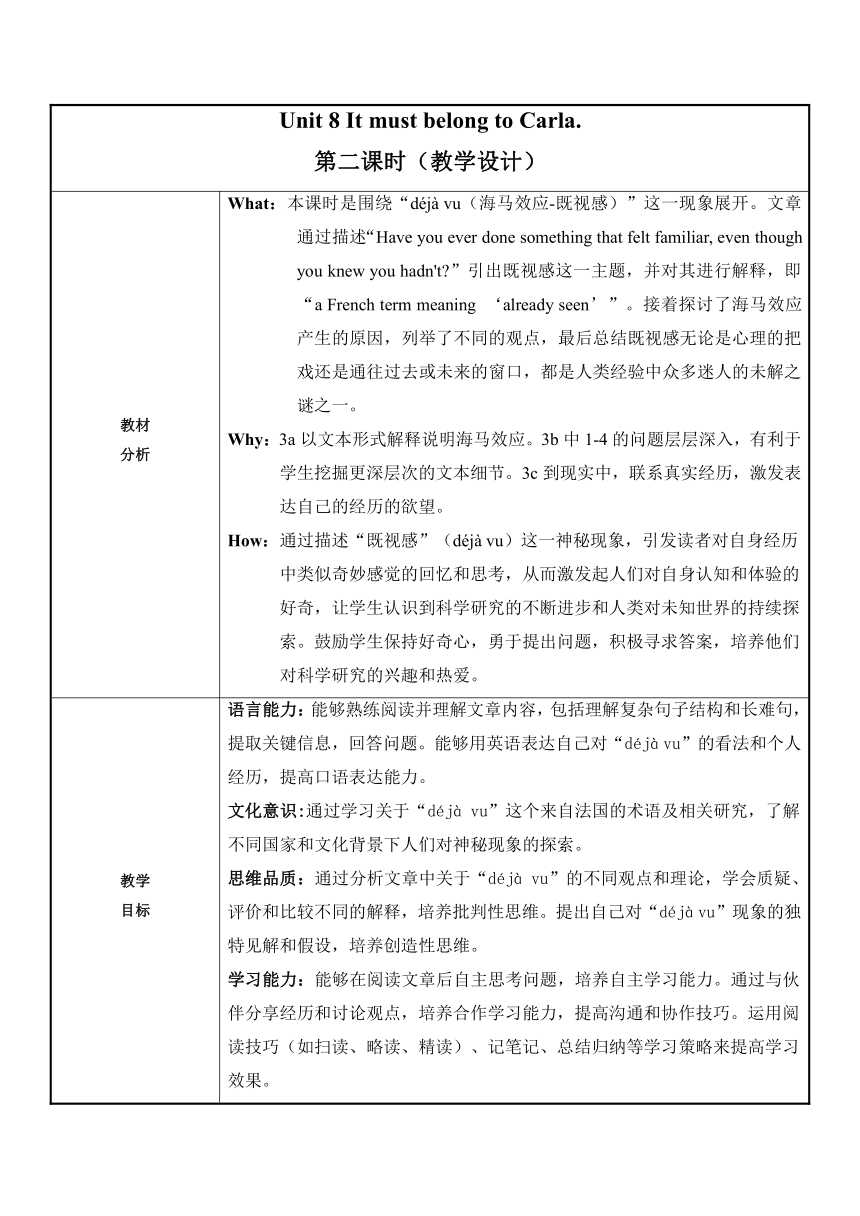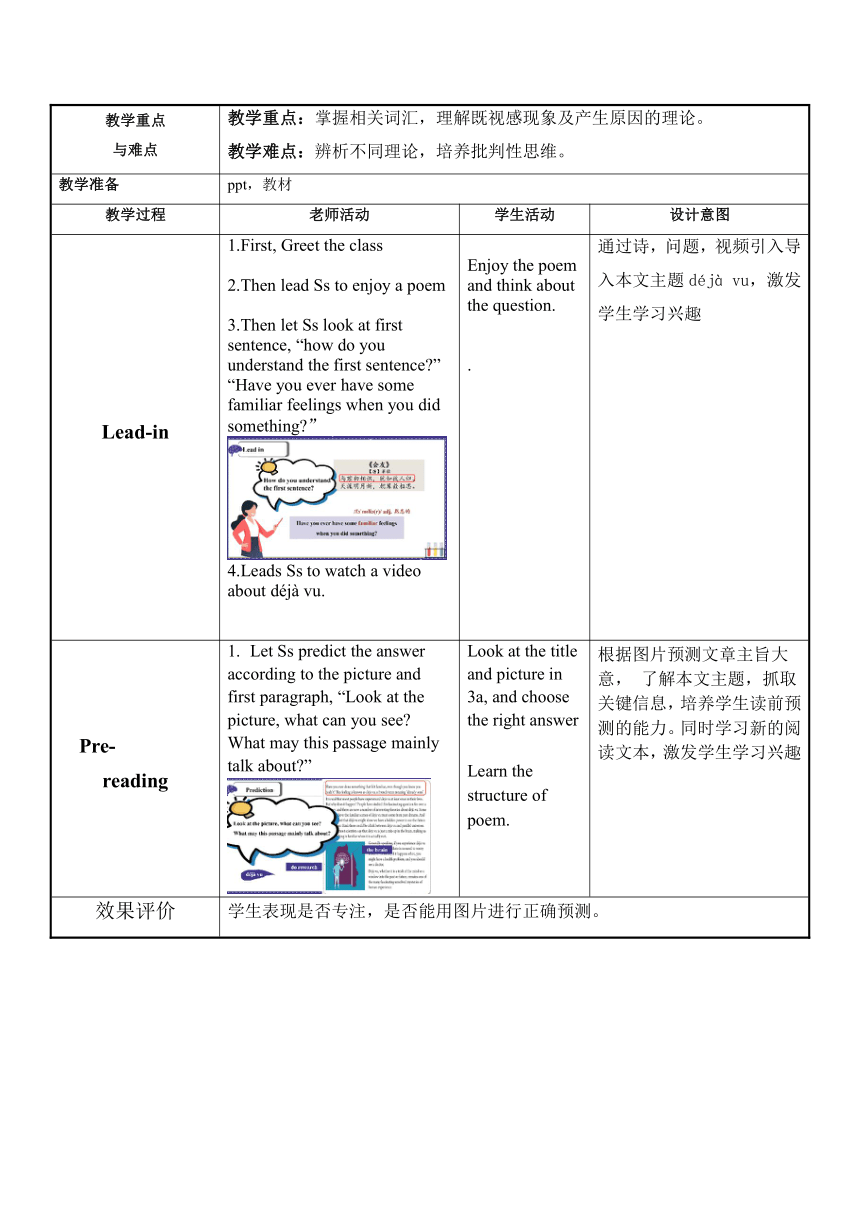Unit 8 It must belong to Carla.第2课时 Section A 3a-3c 教学设计(表格式)九年级英语全一册同步高效课堂(人教版)
文档属性
| 名称 | Unit 8 It must belong to Carla.第2课时 Section A 3a-3c 教学设计(表格式)九年级英语全一册同步高效课堂(人教版) |

|
|
| 格式 | docx | ||
| 文件大小 | 179.4KB | ||
| 资源类型 | 教案 | ||
| 版本资源 | 人教新目标(Go for it)版 | ||
| 科目 | 英语 | ||
| 更新时间 | 2024-09-06 13:44:48 | ||
图片预览


文档简介
Unit 8 It must belong to Carla. 第二课时(教学设计)
教材 分析 What:本课时是围绕“déjà vu(海马效应-既视感)”这一现象展开。文章通过描述“Have you ever done something that felt familiar, even though you knew you hadn't ”引出既视感这一主题,并对其进行解释,即“a French term meaning ‘already seen’”。接着探讨了海马效应产生的原因,列举了不同的观点,最后总结既视感无论是心理的把戏还是通往过去或未来的窗口,都是人类经验中众多迷人的未解之谜之一。 Why:3a以文本形式解释说明海马效应。3b中1-4的问题层层深入,有利于学生挖掘更深层次的文本细节。3c到现实中,联系真实经历,激发表达自己的经历的欲望。 How:通过描述“既视感”(déjà vu)这一神秘现象,引发读者对自身经历中类似奇妙感觉的回忆和思考,从而激发起人们对自身认知和体验的好奇,让学生认识到科学研究的不断进步和人类对未知世界的持续探索。鼓励学生保持好奇心,勇于提出问题,积极寻求答案,培养他们对科学研究的兴趣和热爱。
教学 目标 语言能力:能够熟练阅读并理解文章内容,包括理解复杂句子结构和长难句,提取关键信息,回答问题。能够用英语表达自己对“déjà vu”的看法和个人经历,提高口语表达能力。 文化意识:通过学习关于“déjà vu”这个来自法国的术语及相关研究,了解不同国家和文化背景下人们对神秘现象的探索。 思维品质:通过分析文章中关于“déjà vu”的不同观点和理论,学会质疑、评价和比较不同的解释,培养批判性思维。提出自己对“déjà vu”现象的独特见解和假设,培养创造性思维。 学习能力:能够在阅读文章后自主思考问题,培养自主学习能力。通过与伙伴分享经历和讨论观点,培养合作学习能力,提高沟通和协作技巧。运用阅读技巧(如扫读、略读、精读)、记笔记、总结归纳等学习策略来提高学习效果。
教学重点 与难点 教学重点:掌握相关词汇,理解既视感现象及产生原因的理论。 教学难点:辨析不同理论,培养批判性思维。
教学准备 ppt,教材
教学过程 老师活动 学生活动 设计意图
Lead-in 1.First, Greet the class 2.Then lead Ss to enjoy a poem 3.Then let Ss look at first sentence, “how do you understand the first sentence ” “Have you ever have some familiar feelings when you did something ” 4.Leads Ss to watch a video about déjà vu. Enjoy the poem and think about the question. . 通过诗,问题,视频引入导入本文主题déjà vu,激发学生学习兴趣
Pre- reading Let Ss predict the answer according to the picture and first paragraph, “Look at the picture, what can you see What may this passage mainly talk about ” Look at the title and picture in 3a, and choose the right answer Learn the structure of poem. 根据图片预测文章主旨大意, 了解本文主题,抓取关键信息,培养学生读前预测的能力。同时学习新的阅读文本,激发学生学习兴趣
效果评价 学生表现是否专注,是否能用图片进行正确预测。
While- reading 1. Let Ss read the passage quickly, and find the main idea of each paragraph. Then let Ss choose the right structure of this passage. 2. Let Ss read the passage again and choose the best title What’s the type of the passage Where can you find the passage 3. Let Ss read the first paragraph and answer the question, “What’s déjà vu ” 4. Let Ss read the second paragraph and then finish the mind map. 5. Let Ss read the third and four paragraph and answer the questions. 6.let Ss Read the passage again and check T for true and F for false. Do the fast reading, find the right answer Do the scanning and skimming, find the main idea of each paragraph. Read the article carefully and finish the exercise. 速读文章关键句子快速得到关键信息。 设置每段大意匹配练习,加深对阅读文本的理解,以及进一步培养学生抓住关键信息的能力。 细读文章并完成相应练习,加深对文本的理解,通过梳理,清晰文章脉络,为后文的复述文章做好铺垫。
效果评价 学生是否积极的参与阅读训练,能否正确抓取关键信息。
Post- reading (10 minutes) 1. Let Ss make a brief summary of this passage. 2.let Ss work on 3b-3c in the textbook. Speak out the key sentence patterns to retell the passage Look at 3b and 3c, then finish them on the book. 通过完成文章梳理对文章进行复述。巩固文章内容和知识点。
效果评价 是否激活学生的思维,对所学学习方法进行迁移应用。
Language points (5 minutes) Explain language points in this class. Get to the important language points 学会正确使用本堂课的目标语言。
Summary (2 minutes) Ask Ss to work together and summarize what they have learned in this class. Work in groups and summarize what they have learned. 利用短语展示,将本课的话题及围绕其学习的词汇句型和目标呈现。
Exercises (3 minutes) Ask Ss to finish the exercises on ppt. Finish the exercises. 及时练习,检测学生本堂课知识掌握情况。
Homework 1. Write a short essay titled "My Experience with Déjà Vu", describing a moment of "déjà vu" you have experienced, including your feelings at that time and your thoughts. 2. Discuss the "déjà vu" phenomenon with family or friends. Record their viewpoints and experiences and organize them into a dialogue record.
板书设计 Unit 8 Section A 2
教材 分析 What:本课时是围绕“déjà vu(海马效应-既视感)”这一现象展开。文章通过描述“Have you ever done something that felt familiar, even though you knew you hadn't ”引出既视感这一主题,并对其进行解释,即“a French term meaning ‘already seen’”。接着探讨了海马效应产生的原因,列举了不同的观点,最后总结既视感无论是心理的把戏还是通往过去或未来的窗口,都是人类经验中众多迷人的未解之谜之一。 Why:3a以文本形式解释说明海马效应。3b中1-4的问题层层深入,有利于学生挖掘更深层次的文本细节。3c到现实中,联系真实经历,激发表达自己的经历的欲望。 How:通过描述“既视感”(déjà vu)这一神秘现象,引发读者对自身经历中类似奇妙感觉的回忆和思考,从而激发起人们对自身认知和体验的好奇,让学生认识到科学研究的不断进步和人类对未知世界的持续探索。鼓励学生保持好奇心,勇于提出问题,积极寻求答案,培养他们对科学研究的兴趣和热爱。
教学 目标 语言能力:能够熟练阅读并理解文章内容,包括理解复杂句子结构和长难句,提取关键信息,回答问题。能够用英语表达自己对“déjà vu”的看法和个人经历,提高口语表达能力。 文化意识:通过学习关于“déjà vu”这个来自法国的术语及相关研究,了解不同国家和文化背景下人们对神秘现象的探索。 思维品质:通过分析文章中关于“déjà vu”的不同观点和理论,学会质疑、评价和比较不同的解释,培养批判性思维。提出自己对“déjà vu”现象的独特见解和假设,培养创造性思维。 学习能力:能够在阅读文章后自主思考问题,培养自主学习能力。通过与伙伴分享经历和讨论观点,培养合作学习能力,提高沟通和协作技巧。运用阅读技巧(如扫读、略读、精读)、记笔记、总结归纳等学习策略来提高学习效果。
教学重点 与难点 教学重点:掌握相关词汇,理解既视感现象及产生原因的理论。 教学难点:辨析不同理论,培养批判性思维。
教学准备 ppt,教材
教学过程 老师活动 学生活动 设计意图
Lead-in 1.First, Greet the class 2.Then lead Ss to enjoy a poem 3.Then let Ss look at first sentence, “how do you understand the first sentence ” “Have you ever have some familiar feelings when you did something ” 4.Leads Ss to watch a video about déjà vu. Enjoy the poem and think about the question. . 通过诗,问题,视频引入导入本文主题déjà vu,激发学生学习兴趣
Pre- reading Let Ss predict the answer according to the picture and first paragraph, “Look at the picture, what can you see What may this passage mainly talk about ” Look at the title and picture in 3a, and choose the right answer Learn the structure of poem. 根据图片预测文章主旨大意, 了解本文主题,抓取关键信息,培养学生读前预测的能力。同时学习新的阅读文本,激发学生学习兴趣
效果评价 学生表现是否专注,是否能用图片进行正确预测。
While- reading 1. Let Ss read the passage quickly, and find the main idea of each paragraph. Then let Ss choose the right structure of this passage. 2. Let Ss read the passage again and choose the best title What’s the type of the passage Where can you find the passage 3. Let Ss read the first paragraph and answer the question, “What’s déjà vu ” 4. Let Ss read the second paragraph and then finish the mind map. 5. Let Ss read the third and four paragraph and answer the questions. 6.let Ss Read the passage again and check T for true and F for false. Do the fast reading, find the right answer Do the scanning and skimming, find the main idea of each paragraph. Read the article carefully and finish the exercise. 速读文章关键句子快速得到关键信息。 设置每段大意匹配练习,加深对阅读文本的理解,以及进一步培养学生抓住关键信息的能力。 细读文章并完成相应练习,加深对文本的理解,通过梳理,清晰文章脉络,为后文的复述文章做好铺垫。
效果评价 学生是否积极的参与阅读训练,能否正确抓取关键信息。
Post- reading (10 minutes) 1. Let Ss make a brief summary of this passage. 2.let Ss work on 3b-3c in the textbook. Speak out the key sentence patterns to retell the passage Look at 3b and 3c, then finish them on the book. 通过完成文章梳理对文章进行复述。巩固文章内容和知识点。
效果评价 是否激活学生的思维,对所学学习方法进行迁移应用。
Language points (5 minutes) Explain language points in this class. Get to the important language points 学会正确使用本堂课的目标语言。
Summary (2 minutes) Ask Ss to work together and summarize what they have learned in this class. Work in groups and summarize what they have learned. 利用短语展示,将本课的话题及围绕其学习的词汇句型和目标呈现。
Exercises (3 minutes) Ask Ss to finish the exercises on ppt. Finish the exercises. 及时练习,检测学生本堂课知识掌握情况。
Homework 1. Write a short essay titled "My Experience with Déjà Vu", describing a moment of "déjà vu" you have experienced, including your feelings at that time and your thoughts. 2. Discuss the "déjà vu" phenomenon with family or friends. Record their viewpoints and experiences and organize them into a dialogue record.
板书设计 Unit 8 Section A 2
同课章节目录
- Unit 1 How can we become good learners.
- Section A
- Section B
- Unit 2 I think that mooncakes are delicious!
- Section A
- Section B
- Unit 3 Could you please tell me where the restroom
- Section A
- Section B
- Unit 4 I used to be afraid of the dark.
- Section A
- Section B
- Unit 5 What are the shirts made of?
- Section A
- Section B
- Review of Units 1-5
- Unit 6 When was it invented?
- Section A
- Section B
- Unit 7 Teenagers should be allowed to choose their
- Section A
- Section B
- Unit 8 It must belong to Carla.
- Section A
- Section B
- Unit 9 I like music that I can dance to.
- Section A
- Section B
- Unit 10 You're supposed to shake hands.
- Section A
- Section B
- Review of Units 6-10
- Unit 11 Sad movies make me cry.
- Section A
- Section B
- Unit 12 Life is full of the unexpected
- Section A
- Section B
- Unit 13 We're trying to save the earth!
- Section A
- Section B
- Unit 14 I remember meeting all of you in Grade 7.
- Section A
- Section B
- Review of Units 11-14
